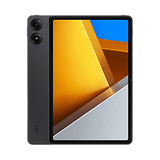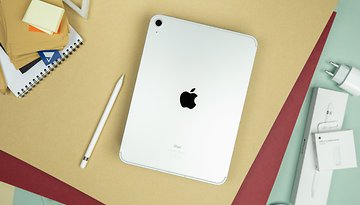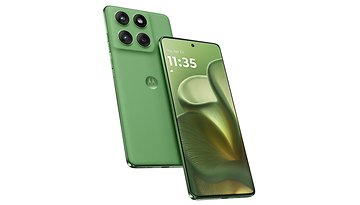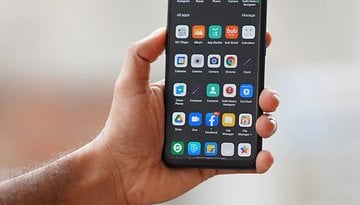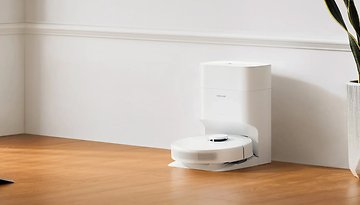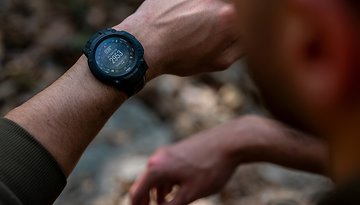Poco Pad Review: Solid First Tablet


The Poco Pad is the brand's first tablet and in typical Poco fashion, it tries to offer a different balance of features and performance for the price. On the other hand, the Poco Pad steps away from the "Gaming" target market with more features for media consumption and even productivity accessories. Let's see how it performs in our review.
Good
- Decent performance for productivity and games
- Good LCD screen
- Wide range of accessories
- Interesting integrations with phones
Bad
- Front camera could be better
- No fingerprint reader

In a nutshell
The first tablet from Poco was launched on the same event as the F6 and F6 Pro duo. In an interview with nextpit, Angus Ng, Poco’s Product Marketing Manager, explained the tablet is not targeted to the usual gaming market, but with a broader market focus.
In line with that thinking, the Poco Pad is powered by the mid-range Snapdragon 7s Gen 2 chip and offers a 12.1-inch LCD screen, with a 16:10 aspect ratio, which is a good compromise between video watching and productivity use. A rather complete set of accessories was also launched with the Poco Pad: A standard cover case, a keyboard cover, and also a stylus.
Pricing for the Poco Pad is approximately $329, depending on the market, with a single memory configuration of 8 GB of RAM and 256 GB of storage. As usual, the tablet will not be officially sold in the US.
Premium look with a good display
The Poco Pad features a 12.1-inch LCD screen with thin bezels. The display has a high 1600p resolution on a 16:10 aspect ratio and 120 Hz refresh rate. The chassis is a sleek unibody made from aluminum with a premium look.
Pros
- Elegant aluminum design.
- Good display with thin bezels.
Cons
- No fingerprint unlock.
The unibody build makes the aluminum cover not only the back but also the sides, giving the Poco Pad an elegant look. The back also features two oversized camera islands, one for the LED flash and another for the tiny lens for the single camera.
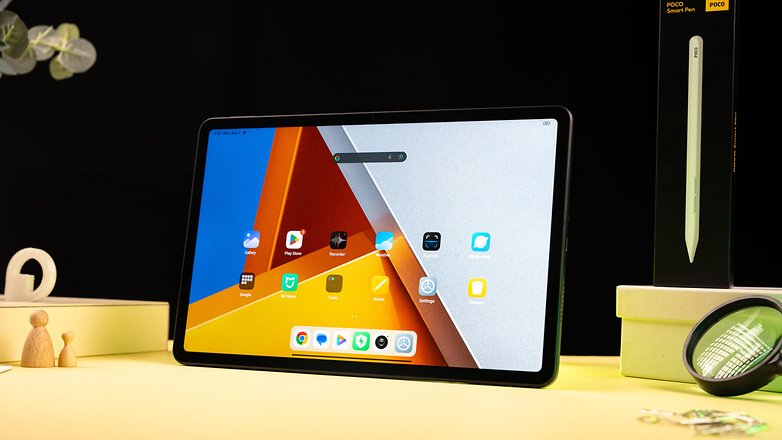
On the edges, with the tablet in the landscape position, you will find the volume buttons and SD card tray on the top long side. The left side lies the power button and two of the quad-speakers, the bottom part is empty, and the right side houses the USB-C port, headphone jack, and the other two speakers.
The display uses a 2560 × 1600 LCD panel with a smooth 120 Hz refresh rate. The specifications are probably overkilling for a portable media consumption device but cover most usage scenarios well. And while the screen doesn’t feature the insanely high brightness levels we are seeing in phones this year, its 500 typical peak brightness (600 nits in HBM) makes things readable in the few situations you may need to use the tablet outdoors.
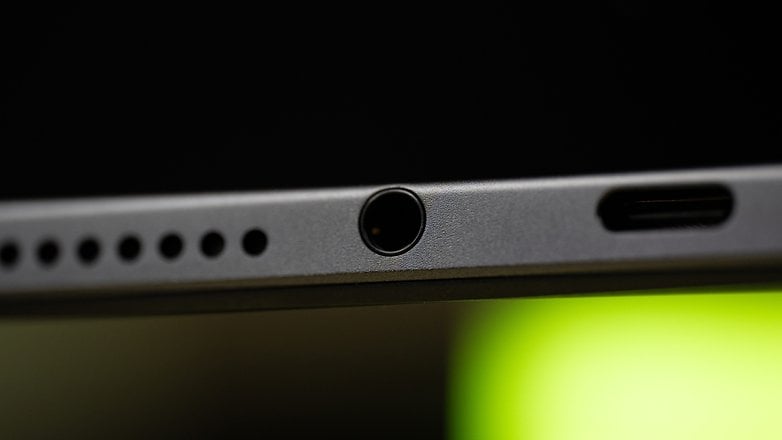
The display is covered by Gorilla Glass 3, and Poco also offers two cover accessories to further protect the Poco Pad: A standard case with a tri-fold cover that doubles as a stand, and a Bluetooth keyboard case with an estimated 760 hours of battery life.
HyperOS shows some integration tricks
Xiaomi’s HyperOS comes onboard the Poco Pad with Android 14 and a rather recent May 2024 security patch. The tablet software can be integrated with other Xiaomi devices and even do some nifty tricks mirroring a compatible phone screen. Poco promises 2 years of system upgrades and three years of security updates.
Pros:
- Recent Android version and security patch.
- Xiaomi/Poco integrations in the system.
- Bloatware kept to a minimum.
Cons:
- Lots of storage used after a factory reset.
Using the Poco Pad for the first time shows a welcome change for the brand (or Xiaomi in general), with only three third-party apps installed (Booking, Netflix, and WPS Office). But not even the low bloatware number was enough to make the tablet come with 33.4 GB of storage, used after updating a fresh installation.
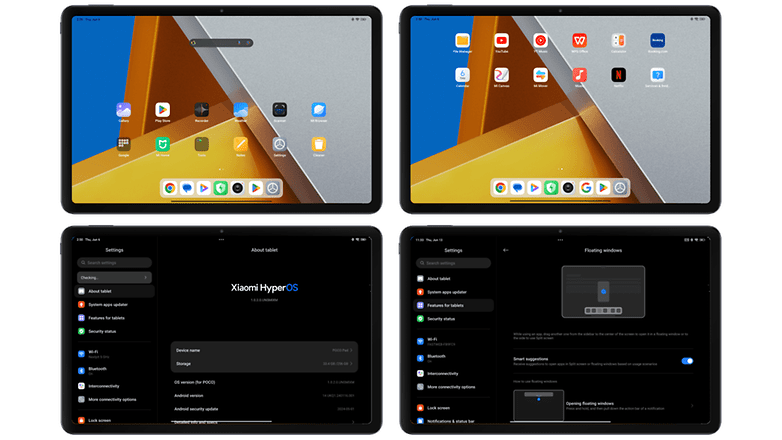
The Poco Pad inherits Xiaomi’s experience in the tablet market with a good set of features tailored to the bigger screen, with a dock, window management options such as split screen, floating screen, and good keyboard integration.
One of the features highlighted during the Poco Pad launch was the option to mirror a phone screen on the tablet and interact with it. At first, it may sound superfluous, but a few days later Apple showcased a similar integration between iOS 18 and macOS Sequoia, so that is one point for the Mi Fans out there.

The feature was recently made available on the Poco F6 and requires signing both devices with the same Mi Account and activating the Xiaomi Smart Hub in the Settings. Users can drag and drop text and images between devices without having the phone stay unlocked. It is even possible to remotely make the phone ring, useful to find a lost device.
Different from the Apple integration, having a touch screen on the tablet makes the user experience more natural than interfacing with a mouse (even the Magic ones). One point that could be improved, however, is integrating phone mirroring with the windows management features in HyperOS.
Mid-range performance
The Poco Pad is powered by the Snapdragon 7s Gen 2 found in a couple of Xiaomi and Poco phones. The memory standards are also suited for the mid-range market, with 8 GB of LPDDR4x RAM and 256 GB of UFS 2.2 storage.
Pros:
- Good performance for the category
- Expandable microSD storage
Cons:
- Slightly warm after heavy use
Don’t expect to have flagship performance from the Poco Pad, as it is clearly positioned in the intermediate market. Using the tablet with video streaming apps worked perfectly fine, and other apps run as expected, even in multitasking situations.
| Poco Pad Snapdragon 7s Gen 2 |
Galaxy Tab S9 FE Exynos 1380 |
iPad 10 Apple A14 |
Pixel Tablet Tensor G2 |
Redmi Pad SE Snapdragon 680 |
Xiaomi Pad 5 Snapdragon 860 |
Fire HD 10 (2023) MediaTek MT8186 |
|
|---|---|---|---|---|---|---|---|
| AnTuTu | 553686 | - | - | 960213 | - | 710946 | - |
| 3DMark Wild Life Extreme Stress Test |
|
|
|
|
|
|
|
| 3DMark Wild Life Stress Test |
|
|
|
|
|
|
|
| Geekbench |
|
|
|
|
|
|
|
Under games, performance was equivalent with modern mid-range phones such as the Redmi Note 13 Pro 5G, Galaxy A55, and the many models powered by the Snapdragon 778 chip.
Esport titles like Call of Duty Mobile ran really well on the Poco Pad, with a good performance. Heavier titles such as Genshin Impact have to run in lower graphical settings, with 30 FPS limit and lower resolutions, for example.
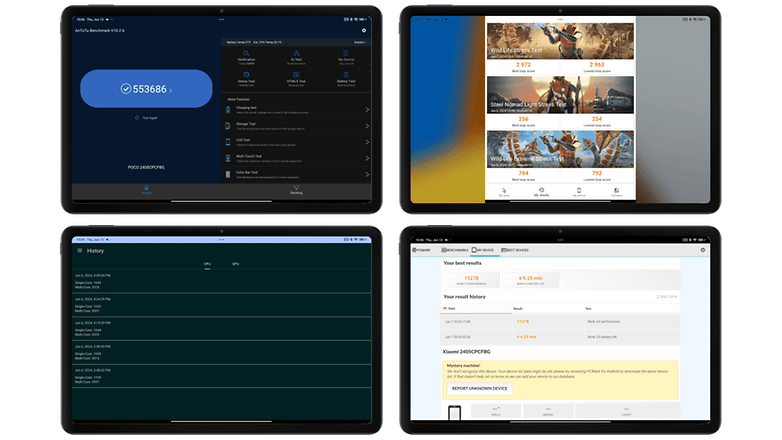
Longer gaming sessions had the tablet got warm, caused not only by the aluminum frame dissipating the heat but probably due to the Snapdragon 7s Gen 2 using the inefficient Samsung 4nm fabrication process.
Big camera, low expectations
Don’t let the big camera modules on the back deceive you, the Poco Pad is equipped with a humble 8-megapixel camera, with a similar resolution for the selfie shooter.
Pros:
- Back camera works fine for simple tasks.
- Landscape orientation for the selfie camera.
Cons:
- Front camera is below average.
- Beauty effect is on by default.
The specs sheet lists similar features from both back and front cameras: 8 MP from a ¼’’ sensor, f/2 aperture for the back camera, and f/2.28 for the selfies.
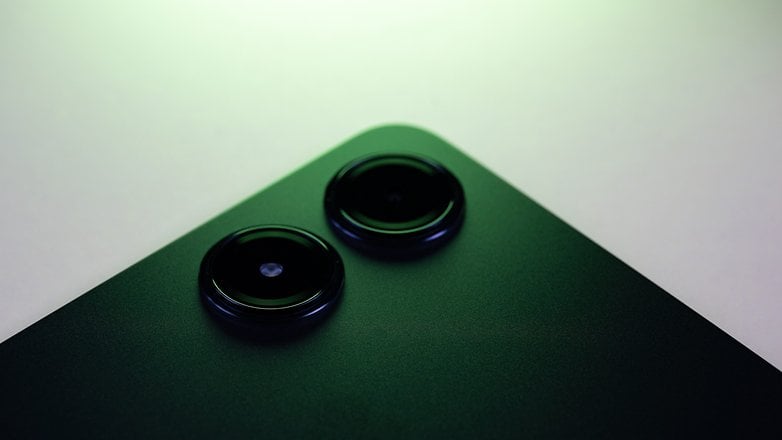
Image quality is within expectations for such small sensors, with low color reproduction, some noise, and issues with low-light scenarios.
The back camera is fine for daily home tasks such as scanning receipts, reading barcodes, and there is even a dedicated document scanning mode on the camera app.
The front camera earns some points for being located in the landscape orientation, matching with the cover accessories to make video calls more practical.
However, image quality from the selfie camera is not the best, with the usual sacrifices found in entry-level phones selfie cameras: Slightly blurry shots at low resolutions. To worsen it, the camera came with the Beauty effect on by default, resulting in unnaturally soft skin, a thinner face, and some skin marks removed.
Battery
Powered by a 10000 mAh battery, the Poco Pad didn’t have a big battery life in our tests, probably due to the not energy efficient chip. On the other hand, the tablet comes with a 33 W power adapter, which offers decent charging times.
Pros:
- Charger included in the box.
Cons:
- Not so energy efficient.
On the PC Mark test that simulates a standard workload and measures the time each device takes between 80% and 20% charge under a 200 nits display, the Poco Pad got a 6h25 runtime with an 11,278 performance points. The result was much lower than the Galaxy Tab S9 FE models, which even got higher performance scores.
| Poco Pad (10000 mAh | 33W) |
Galaxy Tab S9 FE (8000 mAh | UGreen 300W) |
Redmi Pad SE (8000 mAh | 10 W) |
Pixel Tablet (7020 mAh) |
Xiaomi Pad 6 (8840 mAh | 33 W) |
|
|---|---|---|---|---|---|
| 5 min |
|
|
|
|
|
| 10 min |
|
|
|
|
|
| 20 min |
|
|
|
|
|
| 30 min |
|
|
|
|
|
| 1 h |
|
|
|
|
|
| Full charge |
|
|
|
|
|
| PC Mark battery test |
|
|
|
|
|
Charging times were decent with the included 33 W adapter, with a full charge taking around 2h30. 30 minutes was enough for the 27% charge, while an hour at the wall got 51%. The aforementioned Galaxy Tab S9 FE got better charging times, but the Samsung tablet doesn’t come with a charger in the box.
Xiaomi Poco Pad technical specifications
| Poco Pad | |
|---|---|
| Display |
|
| SoC |
|
| Memory |
|
| OS |
|
| Camera |
|
| Selfie Camera |
|
| Battery |
|
| Connectivity |
|
| IP Certification |
|
| Dimensions and weight |
|
| Other points that may interest the nextpit community:
|
|
Final verdict
The Poco Pad is an interesting first try at the tablet market for the Poco brand. The company managed to find a good balance of features for the price, and for a price range that is not overcrowded currently—i.e. $200, $500, and higher.
At the same time, the tablet fits well within the Poco ecosystem, not really replacing the higher-performing phones from the brand, while offering a good experience for watching movies and TV series on the go. And the integration with other Poco/Xiaomi devices makes jumping between them rather seamless—not on the same level as Apple, but on par or better than Samsung.
In the end, the Poco Pad is a solid option for the $300 price range. It should be near the top of the list for Poco users, but even other Android users will be well served by it.
